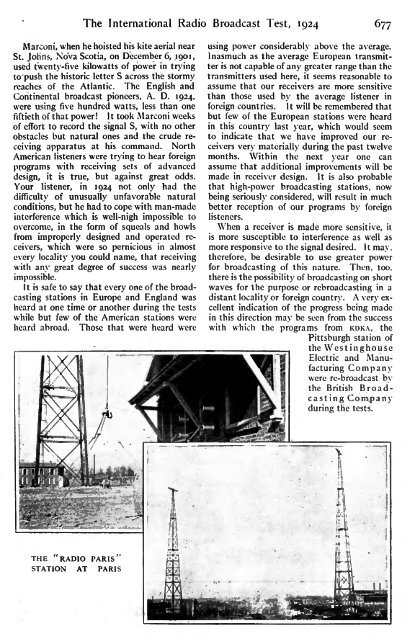Radio Broadcast - 1925, February - 113 Pages ... - VacuumTubeEra
Radio Broadcast - 1925, February - 113 Pages ... - VacuumTubeEra
Radio Broadcast - 1925, February - 113 Pages ... - VacuumTubeEra
Create successful ePaper yourself
Turn your PDF publications into a flip-book with our unique Google optimized e-Paper software.
The International <strong>Radio</strong> <strong>Broadcast</strong> Test, 1924 677<br />
Marconi, when he hoisted his kite aerial near<br />
St. Johns, Nova Scotia, on December 6, 1901,<br />
used twenty-five kilowatts of power in trying<br />
to push the historic letter S across the stormy<br />
reaches of the Atlantic. The English and<br />
Continental broadcast pioneers, A. D. 1924,<br />
were using five hundred watts, less than one<br />
fiftieth of that power! It took Marconi weeks<br />
of effort to record the signal S, with no other<br />
obstacles but natural ones and the crude receiving<br />
apparatus at his command. North<br />
American listeners were trying to hear foreign<br />
programs with receiving sets of advanced<br />
design, it is true, but against great odds.<br />
Your listener, in 1924 not only had the<br />
difficulty of unusually unfavorable natural<br />
conditions, but he had to cope with man-made<br />
interference which is well-nigh impossible to<br />
overcome, in the form of squeals and howls<br />
from improperly designed and operated receivers,<br />
which were so pernicious in almost<br />
every locality you could name, that receiving<br />
with any great degree of success was nearly<br />
impossible.<br />
It is safe to say that every one of the broadcasting<br />
stations in Europe and England was<br />
heard at one time or another during the tests<br />
while but few of the American stations were<br />
heard abroad. Those that were heard were<br />
using power considerably above the average.<br />
Inasmuch as the average European transmitter<br />
is not capable of any greater range than the<br />
transmitters used here, it seems reasonable to<br />
assume that our receivers are more sensitive<br />
than those used by the average listener in<br />
foreign countries. It will be remembered that<br />
but few of the European stations were heard<br />
in this country last year, which would seem<br />
to indicate that we have improved our receivers<br />
very materially during the past twelve<br />
months. Within the next year one can<br />
assume that additional improvements will be<br />
made in receiver design. It is also probable<br />
that high-power broadcasting stations, now<br />
being seriously considered, will result in much<br />
better reception of our programs by foreign<br />
listeners.<br />
When a receiver is made more sensitive, it<br />
more susceptible to interference as well as<br />
is<br />
more responsive to the signal desired.<br />
It may,<br />
therefore, be desirable to use greater power<br />
for broadcasting of this nature. Then, too,<br />
there is the possibility of broadcasting on short<br />
waves for the purpose or rebroadcasting in a<br />
distant locality or foreign country. A very excellent<br />
indication of the progress being made<br />
in this direction may be seen from the success<br />
with which the programs from KDKA, the<br />
Pittsburgh station of<br />
the Westingho'USe<br />
Electric and Manufacturing<br />
Company<br />
were re-broadcast by<br />
the British <strong>Broadcast</strong>ing<br />
Company<br />
during the tests.<br />
THE RADIO PARIS<br />
STATION AT PARIS
















